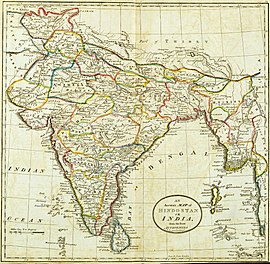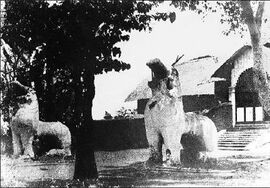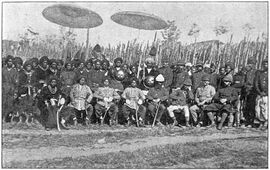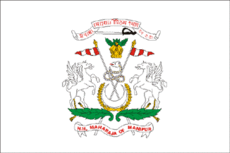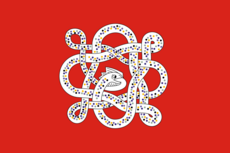History:Manipur (princely state)
Manipur Kingdom Meitei: Meetei Leipak | |||||||||||
|---|---|---|---|---|---|---|---|---|---|---|---|
| 1110–1949 | |||||||||||
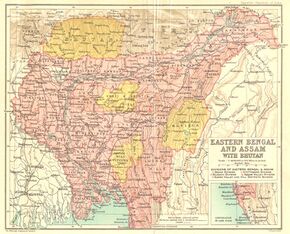 Manipur State in the Hicky's Bengal Gazette of 1907 | |||||||||||
| Capital | Imphal | ||||||||||
| Recognised national languages | Meitei language (officially known as Manipuri) | ||||||||||
| Religion |
| ||||||||||
| History | |||||||||||
• Foundation of the Kangleipak Kingdom | 1110 | ||||||||||
| 1824 | |||||||||||
• Princely state of India | 1891 | ||||||||||
• Accession to the Indian Union | 1947 | ||||||||||
• Merged into the Indian Union | 1949 | ||||||||||
| Area | |||||||||||
| 1941 | 22,372 km2 (8,638 sq mi) | ||||||||||
| Population | |||||||||||
• 1941 | 512,069 | ||||||||||
| |||||||||||
| Today part of | India Myanmar | ||||||||||

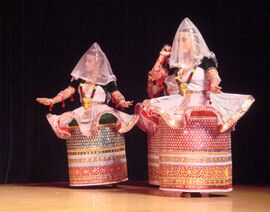
The Manipur Kingdom[1][2][3][4] was an ancient kingdom at the India–Burma frontier.[5][6][7] Historically, Manipur was an independent kingdom ruled by a Meitei dynasty.[8][9][10] But it was also invaded and ruled over by Burmese kingdom at various point of time.[11][12] It became a protectorate of the British East India Company from 1824, and a princely state of British Raj in 1891.[13] It bordered Assam Province in the west and British Burma in the east, and in the 20th century covered an area of 22,327 square kilometres (8,621 sq mi) and contained 467 villages.[citation needed] The capital of the state was Imphal.
Kangleipak State
The early history of Manipur is composed of mythical narratives . The location of the Kangla Fort on the banks of the Imphal River is believed to be where King Pakhangba built his first palace.[14]
Loyumba Shinyen, the written constitution of Kangleipak was formally developed by King Loiyumba (1074–1121) in 1110 AD.[15] He consolidated the kingdom by incorporating most of the principalities in the surrounding hills.[16] After subjugating all the villages within their valley Kangleipak kings grew in power and began a policy of expansion beyond their territory. In 1443 King Ningthoukhomba raided Akla (present day Tamu, Myanmar), an area ruled by Shan people, initiating a policy of Manipuri claims to the neighbouring Kabaw Valley.[16] The zenith of the Kangleipak State was reached under the rule of King Khagemba (1597–1652). Khagemba's brother Prince Shalungba was not happy about Khagemba's rule so he fled to the Taraf where he allied with the local Bengali Muslim leaders. With a contingent of Bengali Muslim soldiers led by Muhammad Sani, Shalungba then attempted to invade Manipur but the soldiers were captured and made to work as labourers in Manipur. These soldiers married local Meitei women and adapted to the Meitei language. They introduced hookah to Manipur and founded the Meitei Pangals (Manipuri Muslim community).[17] It is claimed that Manipur learned the art of making gunpowder from the Chinese merchants who visited the state around 1630 and had started making rockets named Meikappi by the early 18th century.[18]
Manipur State
In 1714, King Pamheiba was initiated into Gaudiya Vaishnavism by Shantidas Gosai, a Bengali Hindu from Sylhet. He made the Gaudiya Vaishnava faith the state religion, replacing Meitei religion, made the Meitei language (aka Manipuri language) written in Bengali script, destroying many documents of Meitei language written in Meitei script and changed his name to Garib Niwaj. In 1724, the Sanskrit name Manipur () was adopted as the name of the state, to make the realm eponymous with Manipura of the Mahabharata. King Garib Niwaj made several incursions into Burma, but made no permanent conquest. After the death of Gharib Nawaz in 1754, Manipur was occupied by the Kingdom of Burma and the Meitei king Bhagyachandra (Meitei: Ching-Thang Khomba) sought help from the British, but when the British refused help he went to Ahom King Rajeswar Singha who sent a force of 40,000 under Haranath Senapati Phukan to free Manipur.[19] A treaty of alliance was negotiated in 1762 and a military force was sent to assist Manipur. The force was later recalled and then the state was left to its own devices.[20] Manipur was invaded at the onset of the First Anglo-Burmese War, together with Cachar and Assam.
British protectorate
Following the Burmese invasions, in 1824 the king of Manipur Gambhir Singh (Chinglen Nongdrenkhomba) asked the British for help and the request was granted. Sepoys and artillery were sent and British officers trained a levy of Manipuri troops for the battles that ensued. After the Burmese were expelled, the Kabaw Valley down to the Ningthi River was added to the state.[20] In 1824–1826, on the conclusion of the First Anglo-Burmese War, Manipur became a British protectorate.[21] Manipur remained relatively peaceful and prosperous until King Gambhir Singh's death in 1834.
At the death of Gambhir Singh, his son Chandrakirti Singh was only one year old, and his uncle Nara Singh was appointed as regent. That same year the British decided to restore the Kabaw Valley to the Kingdom of Burma, which had never been happy about the loss. A compensation was paid to Raja of Manipur in the form of an annual allowance of Rs 6,370 and a British residency was established in Imphal, the only town of the state, in 1835 to facilitate communication between the British and the rulers of Manipur.[20]
After a thwarted attempt on his life, Nara Singh took power and held the throne until his death in 1850. His brother Devendra Singh was given the title of Raja by the British, but he was unpopular. After only three months, the rightful heir Chandrakirti Singh invaded Manipur and rose to the throne. Numerous members of the royal family tried to overthrow Chandrakirti Singh, but none of the rebellions was successful. In 1879, when British Deputy Commissioner G.H. Damant was killed by an Angami Naga party, the king of Manipur assisted the British by sending troops to neighbouring Kohima. Following this service to the crown, Chandrakirti Singh was rewarded with the Order of the Star of India.
After Maharaja Chandrakriti's death in 1886 his son Surachandra Singh succeeded him. As in previous occasions, several claimants to the throne tried to overthrow the new king. The first three attempts were defeated, but in 1890, following an attack on the palace by Tikendrajit and Kulachandra Singh, two of the king's brothers, Surachandra Singh announced his intention to abdicate and left Manipur for Cachar. Kulachandra Singh then rose to the throne while Tikendrajit Singh, as the commander of the Manipuri armed forces, held the real power behind the scenes. Meanwhile, Surachandra Singh, after leaving Manipur, appealed to the British for help to recover the throne.[20]
The 'Manipur Expedition'
The British decided to recognise Kulachandra Singh as Raja, and to send a military expedition of 400 men to Manipur to punish Senapati Tikendrajit Singh as the main person responsible for the unrest and the dynastic disturbances. This action and the violent events that followed are known in British annals as the 'Manipur Expedition, 1891',[22] while in Manipur they are known as the 'Anglo-Manipur War of 1891'.
The British attempt to remove Tikendrajit from his position as military commander (Senapati) and arrest him on 24 March 1891 caused a great stir. The British Residency in Imphal was attacked and the Chief Commissioner for Assam J.W. Quinton, Col. Sken, the British Resident and other British officials were murdered. In the middle of the unrest Ethel St Clair Grimwood, the widow of Frank St Clair Grimmond, the killed British Resident, was credited with leading a retreat of surviving sepoys out of Manipur to Cachar.[23] She was later lauded as a hero.[24]) A 5,000 strong punitive expedition was sent against Manipur on 27 April 1891. Three British columns entered Manipur from British Burma, Cachar and the Naga Hills, which after several skirmishes with the 3,000 men strong Manipuri army, managed to pacify the kingdom. Following the British attack, Tikendrajit and Kulachandra Singh fled, but were captured. Tikendrajit and those Manipuris involved in the killing of the British officers were tried and hanged, while the deposed King Kulachandra Singh and other leaders of the rebellion were sent to the Cellular Jail in the Andaman Islands. Manipur was briefly annexed to British India by virtue of the doctrine of lapse. On 22 September 1891 when Meidingngu Churachand (Churachandra), a 5-year-old boy, was put on the throne, power was restored nominally to the Manipuri crown over the state. During the dynastic disturbances and the British intervention the Naga and Kuki hill tribes of the state lapsed into lawlessness, with numerous instances of murder and arson in the mountain villages, a situation that lasted well into 1894.[20]
The 20th century: Twilight and end of the princely state
The child ruler Churachand belonged to a side branch of the Manipur royal family, so that all the main contenders to the throne were bypassed. While he was a minor the affairs of state were administered by the British Political Agent, which facilitated the introduction and implementation of reforms. The first paved road to Manipur was inaugurated in 1900 —until then there had been no proper roads to reach the kingdom— and this improvement in communication facilitated a visit by Viceroy Lord Curzon in 1901. Raja Churachand was formally declared king in 1907 after completing education in Ajmer.[20] In 1918 he was given the privilege to use the title 'Maharaja' and during his reign Manipur enjoyed a period of relative peace and prosperity. In 1934 king Churachand was knighted by the British, becoming Sir Churachandra Singh.[25]
Between March 1944 and July 1944 part of Manipur and the Naga Hills District of Assam Province were occupied by the Imperial Japanese Army. The capital Imphal was shelled on 10 May 1944.[26][verification needed]
Incorporation into India
On 14 August 1947, with the lapse of paramountcy of the British Crown, Manipur became briefly "independent" in the sense that it was free of control from the Governor of Assam, which may be regarded as reversion to political autonomy that existed before 1891.[27][28][29] However, the Maharaja had signed the Instrument of Accession on 11 August 1947, ceding the three subjects of defence, external affairs and communication to the Union of India.[27][30][31][32][33] A 'Manipur State Constitution Act 1947' was enacted, giving the state its own constitution, although this did not become known in other parts of India owing to the relative isolation of the kingdom.[29] The Government of India did not recognize the Constitution.[34]
On 21 September 1949, the Maharaja was coerced to sign a Merger Agreement with the Union of India, to take effect on 15 October the same year.[35] As a result of the agreement, the Manipur State merged into the Indian Union as a Part C State (similar to a Chief Commissioner's Province under the colonial regime or a Union Territory in the present Indian structure), to be governed by a Chief Commissioner appointed by the Government of India. The representative assembly of Manipur was abolished.[36]
Unhappy with the central rule, Rishang Keishing began a movement for representative government in Manipur in 1954. The Indian home minister, however, declared that the time was not yet ripe for the creation of representative assemblies in Part C States such as Manipur and Tripura, stating that they were located in strategic border areas of India, that the people were politically backward and that the administration in those states was still weak.[36] However, it was given a substantial measure of local self-government under the Territorial Councils Act of 1956, a legislative body and council of ministers in 1963, and full statehood in 1972.[37]
Rulers
The rulers of Manipur state were entitled to an 11-gun salute by the British authorities. The present dynasty began in 1714.[38]
- 1709–1754 Gharib Nawaz (Pamheiba) (d. 1754)
- 1754–1756 Bharat Shah (Chitsai)
- 1756–1764 Guru Sham (Gaurisiam) (d. 1764)
- 1764–1798 Jai Singh (Bhagya Chandra)
- 1798–1801 Rohinchandra (Harshachandra Singh) (d. 1801)
- 1801–1806 Maduchandra Singh (d. 1806)
- 1806–1812 Charajit Singh (d. 1812)
- 1812–1819 Marjit Singh (d. 1824)
Rajas under Burmese rule
There were two feudatory kings during the time of the Burmese invasions.
- 1819–1823 Shubol
- 1823–1825 Pitambara Singh
Rajas under British protection
- 26 Jun 1825 – 9 January 1834 Gambhir Singh (d. 1834)
- 1834–1844 Nara Singh – Regent (d. 1850)
- 1844 – 10 April 1850 Nara Singh (s.a.)
- 1850 (3 months) Devendra Singh (d. 1871)
- 1850 – May 1886 Chandrakirti Singh (s.a.) (b. 1831 – d. 1886) (from 18 February 1880, Sir Chandrakirti Singh)
- 1886 – 24 September 1890 Surachandra Singh (d. 1891)
- 24 Sep 1890 – 19 April 1891 Kulachandra Singh (b. 18.. – d. 1934)
- 19 Apr 1891 – 18 September 1891 Interregnum
- 18 Sep 1891 – 1918 Churachandra Singh (b. 1885 – d. 1941)
Maharajas
- 1918 – Sep 1941 Sir Churachandra Singh (s.a.) (from 1 January 1934, Sir Churachandra Singh)
- Sep 1941 – 15 October 1949 Bodhchandra Singh (b. 1909 – d. 1955)
British administrators
- Political agents
The Political agents were subordinated to the Chief Commissioner of Assam (Lieutenant Governor of East Bengal and Assam during 1905–1912)
- 1835–1844 George Gordon[citation needed]
- 1844–1863 William McCulloch (1st time)[39]
- 1865–1867 William McCulloch (2nd time) (s.a.)
- 1867–1875 Robert Brown [citation needed]
- 1875–1877 Guybon Henry Damant (acting)
- 1877–1886 Sir James Johnstone[citation needed]
- 1886 (6 weeks) Trotter (acting)
- 25 Mar 1886 – 21 April 1886 Walter Haiks (acting)
- 1886 – 24 April 1891 St. Clair Grimwood (d. 1891)
- 1891 Sir Henry Collett (British commander)
- 1891–1893 H.St.P. John Maxwell (1st time)
- 1893–1895 Alexander Porteous (1st time)
- 1895–1896 H.St.P. John Maxwell (2nd time)
- 1896–1898 Henry Walter George Cole (1st time) (acting)
- 1898–1899 Alexander Porteous (2nd time)
- 1899–1902 H.St.P. John Maxwell (3rd time)
- 1902–1904 Albert Edward Woods
- 1904–1905 H.St.P. John Maxwell (4th time)
- 1905–1908 John Shakespear (1st time)
- 1908–1909 A.W. Davis
- 1909–1914 John Shakespear (2nd time)
- 1914–1917 Henry Walter George Cole (2nd time) (s.a.)[clarification needed]
- 1917–1918 John Comyn Higgins (1st time)
- 1918–1920 William Alexander Cosgrave
- 1920–1922 L.O. Clarke (1st time)
- 1922 Christopher Gimson (1st time) (acting)
- 1922–1924 L.O. Clarke (2nd time)
- 1924–1928 John Comyn Higgins (2nd time) (s.a.)
- 12 Mar 1928 – 23 November 1928 C.G. Crawford
- 1928–1933 John Comyn Higgins (3rd time) (s.a.)
- 1933–1938 Christopher Gimson (2nd time) (s.a.)
- 1938–1941 Gerald Pakenham Stewart (1st time) (Japanese prisoner 1941–45)
- 1941–1946 Christopher Gimson (3rd time) (s.a.)
- Dec 1946 – 14 August 1947 Gerald Pakenham Stewart (2nd time)
Indian administration
- Political agents
The Indian Agents were subordinated to the Governor of Assam.
- Dewans
The Dewans were representing the Governor of Assam.
- 1948 – 16 April 1949 Maharaj Kumar Priyobrata Singh (s.a.)[40]
- 16 Apr 1949 – 15 October 1949 Rawal Amar Singh[41]
Flags
The State of Manipur had a set of two flags, a white one and a red one. All featured the Pakhangba dragon in the centre, although not as prominently in the latter flags.[42]
See also
- History of Manipur
- Manipur State Constitution Act 1947
- Meitei inscriptions
- Ningthouja dynasty
- Meitei mythology
- Political integration of India
References
- ↑ Keen, Caroline (2015). An Imperial Crisis in British India. I.B. Tauris. p. 150-152. doi:10.5040/9780755624355. ISBN 978-1-78673-987-2. http://dx.doi.org/10.5040/9780755624355. "Ghose maintained that under the Indian Penal Code only subjects of the Queen or foreigners residing in British India could be guilty of waging war against the Queen. Manipur was an independent sovereign state and.."
- ↑ Lloyd, Nick (2016). "Review of AN IMPERIAL CRISIS IN BRITISH INDIA: THE MANIPUR UPRISING OF 1891". Journal of the Society for Army Historical Research 94 (380): 347–348. ISSN 0037-9700. https://www.jstor.org/stable/44233143.
- ↑ Sen (1992), p. 17
- ↑ Andaya, Barbara Watson; Andaya, Leonard Y. (2015-02-19). A History of Early Modern Southeast Asia, 1400–1830. Cambridge University Press. p. 264. doi:10.1017/cbo9781139051323. ISBN 978-0-521-88992-6. http://dx.doi.org/10.1017/cbo9781139051323.
- ↑ Somorjit, Wangam (2016-03-01) (in en). Manipur: The Forgotten Nation of Southeast Asia. Waba Publications & Advanced Research Consortium. ISBN 978-81-926687-2-7. https://books.google.com/books?id=mhDvsgEACAAJ.
- ↑ Fantz, Paul R.; Pradeep, S. V. (1995) (in en). Clitoria (Leguminosae) of South Eastern Asia. http://archive.org/details/nelumbo-2455-376x-37-1-4-001-037.
- ↑ https://press.uchicago.edu/books/HOC/HOC_V2_B2/HOC_VOLUME2_Book2_chapter18.pdf [bare URL PDF]
- ↑ Arora, Vibha; Kipgen, Ngamjahao (2012). "The Politics of Identifying with and Distancing from Kuki Identity in Manipur". Sociological Bulletin 61 (3): 429–449. doi:10.1177/0038022920120303. ISSN 0038-0229. https://www.jstor.org/stable/26290634. "Historically, Manipur was an independent kingdom ruled by Meitei dynasty. The physical boundary of Manipur has been fluctuating with historical changes in political power and the intra state and the inter state boundaries".
- ↑ Singha, Memchaton (2016). "Marriage Diplomacy Between the States of Manipur and Burma, 18th to 19th Centuries". Proceedings of the Indian History Congress 77: 874–879. ISSN 2249-1937. https://www.jstor.org/stable/26552717. "Both Manipur and Burma succeeded in maintaining their status as independent princely states until the British occupation by in the last part of 19th century".
- ↑ Waikhom, Rangitabali (2002). "Women's Society and Politics in Pre-Colonial Manipur". Proceedings of the Indian History Congress 63: 1356–1357. ISSN 2249-1937. https://www.jstor.org/stable/44158255.
- ↑ Thant, Myint-U (2001), The Making of Modern Burma, Cambridge University Press, p. 15, ISBN 978-0-521-79914-0, https://books.google.com/books?id=gMH_GlTgftcC
- ↑ Lieberman, Victor (1996). "POLITICAL CONSOLIDATION IN BURMA UNDER THE EARLY KONBAUNG DYNASTY 1752 – c. 1820". Journal of Asian History 30 (2): 152–168. ISSN 0021-910X. https://www.jstor.org/stable/41931038.
- ↑ Chisholm, Hugh, ed (1911). "Manipur". Encyclopædia Britannica. 17 (11th ed.). Cambridge University Press. p. 582.
- ↑ Yuhlung, Cheithou Charles (2013). "The Identity of Pakhangpa: The Mystical Dragon-Python God of Chothe of Manipur" (in en). SSRN Electronic Journal. doi:10.2139/ssrn.2317260. ISSN 1556-5068. http://www.ssrn.com/abstract=2317260.
- ↑ Bhattacharjee, J.B.; Bhattacharya, J.B. (2003). "'Loiyamba Shinyen': A Landmark in Meitei State Formation in Medieval Manipur". Proceedings of the Indian History Congress 64: 362–368. ISSN 2249-1937. https://www.jstor.org/stable/44145476.
- ↑ 16.0 16.1 Phanjoubam Tarapot, Bleeding Manipur, Har Anand Publications (30 July 2007) ISBN:978-8124109021
- ↑ Nath, Rajmohan (1948). The back-ground of Assamese culture. A. K. Nath. p. 90. https://archive.org/details/in.ernet.dli.2015.126984.
- ↑ Laichen 2003, pp. 505-506.
- ↑ Comprehensive history of Assam, SL Baruah. pp. 296–297.
- ↑ 20.0 20.1 20.2 20.3 20.4 20.5 "Imperial Gazetteer2 of India, Volume 17, page 186 – Imperial Gazetteer of India – Digital South Asia Library". https://dsal.uchicago.edu/reference/gazetteer/pager.html?objectid=DS405.1.I34_V17_192.gif.
- ↑ Phanjoubam, Pradip (2015), The Northeast Question: Conflicts and frontiers, Routledge, pp. 3–4, ISBN 978-1-317-34004-1, https://books.google.com/books?id=OxStCwAAQBAJ: "After comprehensively defeating the Burmese in 1826 in Assam and Manipur, and the signing of the Treaty of Yandabo, the British annexed Assam, but allowed Manipur to remain a protectorate state."
- ↑ Ian F.W. Beckett, Victoria's Wars, Shire, ISBN:978-0747803881, p. 62
- ↑ Reynolds, K. D. (2010). "Grimwood [née Moore; other married name Miller, Ethel Brabazon [pseud. Ethel St Clair Grimwood] (1867–1928), the heroine of Manipur"] (in en). Oxford Dictionary of National Biography (online ed.). Oxford University Press. doi:10.1093/ref:odnb/101006. https://www.oxforddnb.com/view/10.1093/ref:odnb/9780198614128.001.0001/odnb-9780198614128-e-101006. Retrieved 2020-10-11. (Subscription or UK public library membership required.)
- ↑ Ethel St. Clair Grimwood, My Three Years in Manipur and Escape from the Recent Mutiny (fl.1891)
- ↑ "Indian Princely States K-Z". http://www.worldstatesmen.org/India_princes_K-W.html.
- ↑ Pum Khan Pau (2012) Tedim Road—The Strategic Road on a Frontier: A Historical Analysis, Strategic Analysis, 36:5, 776-786, doi: 10.1080/09700161.2012.712387
- ↑ 27.0 27.1 Subramanian, K. S.. State, Policy and Conflicts in Northeast India. Routledge & CRC Press. pp. 31–32. https://www.routledge.com/State-Policy-and-Conflicts-in-Northeast-India/Subramanian/p/book/9780815393009.
- ↑ Akoijam, A. Bimol (28 July 2001), "How History Repeats Itself", Economic and Political Weekly 36 (30): 2807–2812
- ↑ 29.0 29.1 Banerjee, S. K. (January–March 1958), "Manipur State Constitution Act, 1947", The Indian Journal of Political Science 19 (1): 35–38
- ↑ Colonialism and Resistance: Society and State in Manipur, Taylor & Francis, 2015, p. 169, ISBN 9781317270669, https://books.google.com/books?id=OzjbCgAAQBAJ&dq=Manipur+instrument+of+accession&pg=PA169, retrieved 14 January 2021
- ↑ Why Pre-Merger Political Status for Manipur: Under the Framework of the Instrument of Accession, 1947, Research and Media Cell, CIRCA, 2018, p. 26, GGKEY:8XLWSW77KUZ, https://books.google.com/books?id=oKZoDwAAQBAJ&pg=PA26: "Before the controversial merger, both Manipur and India were bound by the Instrument of Accession (IOA) which the King of Manipur signed on 11 August 1947. The IOA was accepted by the Governor General of India Lord Mountbatten on 16 August 1947 vide Home Department, Government of India file no A-1/1/1947. Subsequently, the Manipur State Council approved the IOA in its meeting held on 22 August 1947 Vide Memo No. 383 PTI Reference Council Minutes Part I of 11-8-1947. The execution of the Instrument of Accession was published in the Manipur State Gazette on 27 August 1947."
- ↑ Singh, Socio-religious and Political Movements in Modern Manipur 2011, p. 139; See Chapter 2 for the limitations of sovereignty under the colonial regime.
- ↑ "Instrument of Accession of the State of Manipur". https://upload.wikimedia.org/wikipedia/commons/b/b0/Instrument_of_Accession_and_Standstill_Agreement_of_Manipur_to_Dominion_of_India.pdf.
- ↑ Singh, Socio-religious and Political Movements in Modern Manipur (2011), Chapter 6, p. 145.
- ↑ Haokip, Thongkholal (2012). "Political Integration of Northeast India: A Historical Analysis". Strategic Analysis 36 (2): 304–314. doi:10.1080/09700161.2012.646508. ISSN 0970-0161.: "The Maharajah of Manipur was invited to Shillong in September 1949 for talks on integration.... The Maharaja was placed under house arrest and debarred from any communication with the outside world. The Maharaja was thus forced to sign the ‘Merger Agreement’ with India on September 21, 1949, and Manipur became a 'Part-C state' of the Indian Union."
- ↑ 36.0 36.1 Guha, Ramachandra (2008), India after Gandhi: The History of the World's Largest Democracy, Pan Macmillan, Section 13.V, ISBN 978-0330396110, https://books.google.com/books?id=29lXtwoeA44C
- ↑ Agnihotri, Constitutional Development in North-East India (1996), p. 68.
- ↑ "MANIPUR". http://members.iinet.net.au/~royalty/ips/m/manipur.html.
- ↑ "Page:Dictionary of National Biography volume 35.djvu/27 - Wikisource, the free online library". https://en.wikisource.org/wiki/Page:Dictionary_of_National_Biography_volume_35.djvu/27.
- ↑ 40.0 40.1 40.2 Singh, Socio-religious and Political Movements in Modern Manipur (2011), pp. 139–140.
- ↑ Singh, Socio-religious and Political Movements in Modern Manipur (2011), pp. 141–142.
- ↑ "Manipur". http://www.crwflags.com/fotw/flags/in-manip.html.
Bibliography
- Laichen, Sun (2003). "Military Technology Transfers from Ming China and the Emergence of Northern Mainland Southeast Asia (c. 1390-1527)". Journal of Southeast Asian Studies (Cambridge University Press) 34 (3): 495–517. doi:10.1017/S0022463403000456. http://ruhm.es/index.php/RUHM/article/view/808.
- Agnihotri, S. K. (1996), "Constitutional Development in North-East India since 1947", in B. Datta-Ray; S. P. Agrawal, Reorganization of North-East India Since 1947, Concept Publishing Company, pp. 57–92, ISBN 978-81-7022-577-5, https://books.google.com/books?id=v44gVIFltgQC&pg=PA69
- Singh, Haorongbam Sudhirkumar (2011), "Socio-religious and Political Movements in Modern Manipur 1934–51", INFLIBNET (Jawaharlal Nehru University/Shodhganga), http://shodhganga.inflibnet.ac.in/handle/10603/121665
- L. Joychandra Singh, The Lost Kingdom: Royal Chronicle of Manipur, Prajatantra Publishing House, 1995.
- Sen, Sipra (1992), Tribes and Castes of Manipur: Description and Select Bibliography, Mittal Publications, ISBN 81-7099-310-5, https://books.google.com/books?id=bQQNCU-QWBAC&q=Brahmins+in+manipur&pg=PA68
External links
| Wikimedia Commons has media related to Manipur (princely state). |
- Territorial Councils Act, 1956, Lok Sabha Bills, retrieved 25 November 2020.
- Puya – Meithaba: The Date Controversy
- Seven clans of Manipur
[ ⚑ ] 24°49′N 93°57′E / 24.817°N 93.95°E
- Government of Manipur (1949). Manipur Gazette, 1949, January–June. pp. 1–5. http://archive.org/details/in.ernet.dli.2015.125717.
- Hosting sites of FOTW, National Flag
 |


